30 October 2023
![]() 14 mins Read
14 mins Read
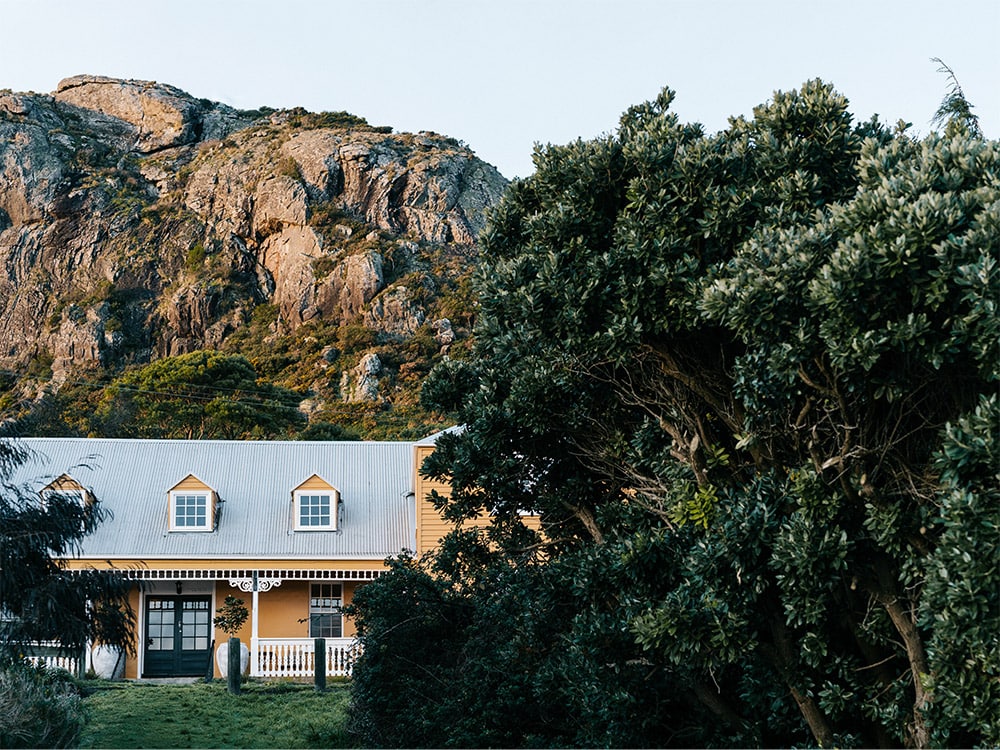
Once home to the headquarters of the Van Diemen’s Land Company, today Stanley attracts plenty of historians, but also bushwalkers exploring the nearby Tarkine wilderness, beachcombers and wildlife lovers out to spot fur seals and penguins on Tasmania’s north-west coast. Its streets are a chocolate-box collection of colonial buildings and quaint cottages, and a new boutique hotel set in an old sailors’ tavern has just created another reason to visit.
Built as a pub in 1849 by a prime minister’s grandfather, the Ship Inn Stanley is now a storytelling hotel that combines a boutique stay with the chance to be immersed in the area’s many layered history.
The stories are woven throughout each of the Ship Inn’s seven suites, which include: the Wild Wave, named after the tall ship that met its fate on the bay below; Lyons Retreat, which tells the tale of Joseph Lyons, Australia’s first Tasmanian-born prime minister who was born in the weatherboard cottage next door; and Bayview, once part of the pub’s old cabaret rooms. The stories alone will entice you back for another stay.
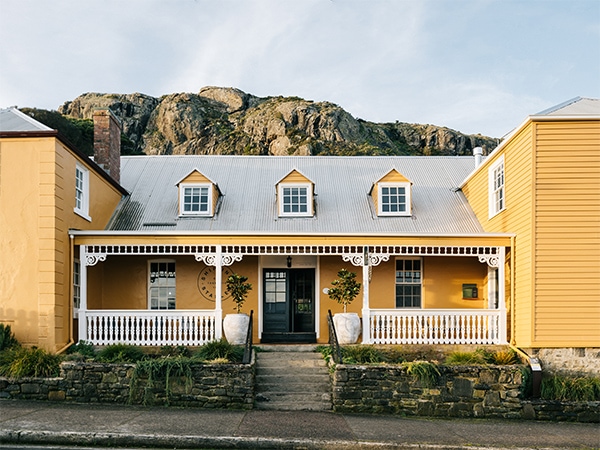
Stay at the Ship Inn Stanley, a boutique storytelling hotel. (Credit Marnie Hawson)
You’ll find Moss Hotel retrofitted into two historic Georgian buildings on the waterfront of Hobart’s Salamanca Place. Access is gained through a green glass door that hints at the experience to come.
Climbing the sandstone-lined staircase, a cosy lounge space that effectively serves as the property’s reception opens up in front of you. With its subdued lighting and requisite open fire burning low, the area envelops guests rather than merely welcoming them.
More sandstone and original wooden beams above are rustic yet proud, and the inclusion of a large woven wool wall hanging introduces a soft, tactile focal point. Check-in is a casual affair, all the better to hasten the arrival into one of the property’s 41 rooms.
Pushing open the door, the interiors are sleek and well formed. There is ample use of warm wood in the fittings throughout, contrasted against dark walls, and with lighting that enhances the feel created by all of the complementary elements.
A generous king-size bed dominates the space, while a duo of locally made chairs have a retro Scandi vibe, with tones of green used on the upholstery, and layered with fluffy sheepskins. But it’s the bathrooms that really stand out: covered from floor to ceiling in glossy green ceramic tiles laid out in a mesmerising chevron pattern, offset with pearly-white basins and soaking tubs.
When you’re ready to explore the city’s food offerings, head to Small-fry for breakfast, where the space is tiny but flavours are big; grab coffee at Room for a Pony; score baked goods at Battery Point’s Jackman & McRoss; book a table at vibrant Suzie Luck’s for its Asian fusion menu and clever cocktails; try Fico for Italian with a hint of Japanese; and feast on Tasmanian comfort food at Peacock and Jones in the Henry Jones Art Hotel.

Stay at the lavish Moss Hotel in Hobart.
Picnic Island is a privately owned island in Tasmania’s Coles Bay, within Freycinet National Park, that’s available in its entirety for holiday lease. Owner Clem Newton-Brown originally used the island for rugged camping trips with his family, but it now boasts two beautifully weathered copper-clad buildings.
These buildings are connected by a boardwalk: one contains five bedrooms, sleeping up to 10 people, while the other features a kitchen, dining and living space, complete with suspended fireplace and magnificent ocean views.
Accessible only by boat, Picnic Island has spectacular views of the Hazards mountain range. Dolphins can be spotted passing by, and a walk around the island after dark reveals scores of fairy penguins returning to their burrows for the night.
Guests can enjoy fishing, swimming and foraging for mussels at low tide. It is the ultimate setting for an off-grid getaway, family adventure or simply to reconnect with nature.

Stay on your own private island in Tasmania on Picnic Island. (Credit Annette O’Brien)
Kittawa Lodge was dreamt up to be a place where busy people can unwind and breathe deeply – its island home, in fact, has some of the cleanest air in the world. Welcome to a unique new accommodation offering on Tasmania’s King Island, which lies, rugged and beautiful, off the state’s north-west coast (accessible by plane from the mainland or a 30-minute flight from Melbourne).
At Kittawa, two architecturally designed lodges sit snug in the sand dunes on the property’s 750 metres of coastline. The bespoke structures were made on mainland Tasmania from sustainable materials and feature charred timber cladding, which is inspired by a Japanese technique that provides a natural resistance to bushfires and is well equipped to weather the elements over time.
With sweeping views across the Bass Strait from every room, the two lodges are designed to maximise guests’ connection to the outdoors. The interiors feature luxurious bamboo linen, a handmade concrete bath and original artworks by renowned King Island-based artists.
And, of course, no Tassie experience would be complete without lashings of local produce, and King Island does it particularly well – it’s renowned for its seafood, cheese and beef.
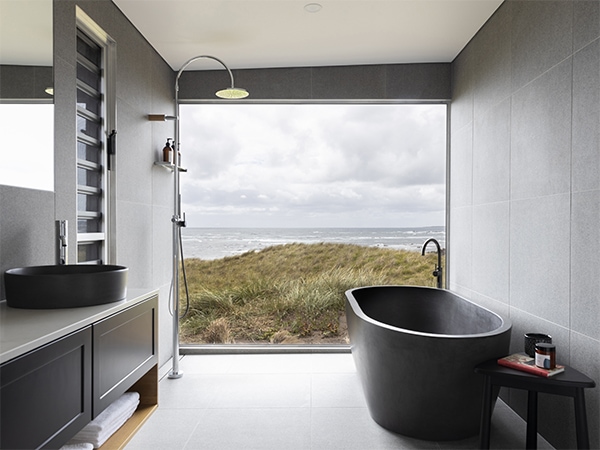
Enjoy sweeping views across the Bass Strait from every room at Kittawa Lodge.
Flinders Island is the largest in the Furneaux Group, all at sea in the Bass Strait, north-east of Tasmania. Renowned for its pristine, if wild, waters that harbour some of Australia’s best seafood, it’s long been a chef’s secret pantry.
Some 900 islanders live on Flinders, among them farmers, growers and producers who are passionate about producing food the way it used to be done. Terrestrial spoils include beef, lamb, garlic, honey, fruit and vegetables, as well as premium Tasmanian whisky, gin and beer.
At the heart of the island’s community, The Flinders Wharf restaurant celebrates this abundance by hosting seasonal crayfish experiences, as well as a monthly guest chef culinary program, ‘On-Island Time’.
Providing another reason to visit – and stay awhile, The Flinders Wharf also manages two chic and cosy farmstays on the Quoin angus beef farm. Dwarf Cottage is a gorgeous studio space perfect for couples, while newly opened Wombat Lodge is a beautiful three-bedroom affair complete with a designer bathroom with a deep tub looking out across farmland and mountains (the lodges are ideally located for accessing the walking trails of Mt Killiecrankie, a large granite crag with spectacular scenery). And it’s got a chef-inspired kitchen, of course.

Indulge on a foodie holiday to Flinders Island in Tasmania. (Credit Luke Tscharke)
Sure, we’re a sucker for a slick new design hotel or a carefully curated Airbnb, but we have a particular soft spot for a classic, too. Especially if that classic sits right on the doorstep of Tasmania’s spectacular, World Heritage-listed Cradle Mountain-Lake St Clair National Park.
A two-hour scenic drive from Launceston, Cradle Mountain Lodge is set lightly on this landscape and offers four different styles of accommodation, from the contemporary Pencil Pine Cabins to the luxurious King Billy Suites. It has the timeless feel of an alpine lodge and all the added benefits of Tasmanian produce, wine and warm hospitality.
But of course, the main reason you’re here is to explore the icons of the Tasmanian wilderness that are the towering Cradle Mountain with its ragged twin peaks and the picturesque Dove Lake that lies, mirror-like, at its foot.
Some of the mountain’s best – and easiest – hikes leave from the doorstep of Cradle Mountain Lodge. Choose from over 20 different self-guided walking tracks, ranging from gentle meanders through buttongrass plains and moss myrtle forests to clambering to the top of Dove Canyon, and the Dove Lake circuit walk, a six-kilometre jaunt and one of Tasmania’s best short walks.
And if you are game for taking on the Cradle Mountain summit hike itself, what better way to reward yourself than with a session in the Sanctuary – the Waldheim Alpine Spa’s dedicated therapeutic area, followed by a room-service platter of Tasmanian cheese by the log fire?
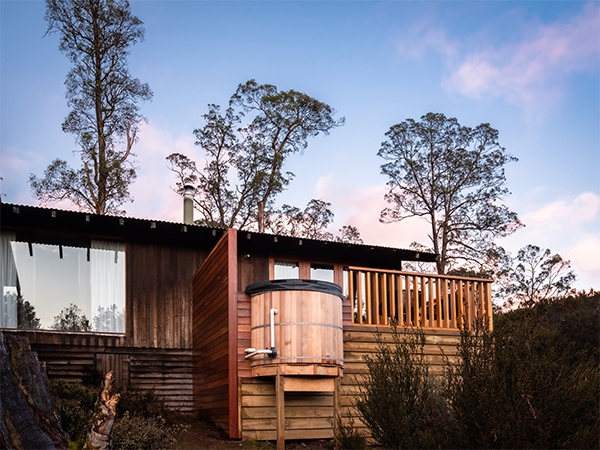
Cradle Mountain Lodge is set lightly on this landscape and offers four different styles of accommodation.
On the west coast of Tasmania, you might come across depressions that were once Aboriginal huts: large beehive-shaped structures of wood and bark that would accommodate up to 14 people. This is just one fascinating example of the Indigenous culture that is hidden in plain sight in a state where a pervasive myth throughout much of the 20th century did its best to erase it. Today, the word palawa refers to Tasmanian Aboriginal people as a whole, but encompasses the many different groups from all around Tasmania. Here are ways you can experience this culture through both a contemporary and historical lens today.
The Wukalina Walk was Tasmania’s first Indigenous owned and operated tourism venture. A four-day walk in the state’s north-east, around the spectacular landscapes of the larapuna/Bay of Fires and wukalina/Mt William areas.
Local and family-owned Kooparoona Niara Tours runs bespoke day trips through the Meander Valley near Launceston that combine visits to Aboriginal cultural sites and a view of contemporary Indigenous culture with a taste of the region’s standout produce.
Local Ben Rea, of Tasmanian E-Bike Adventures, has paired with Sheldon Thomas, a Tasmanian Aboriginal healer, cultural and ceremonial guide, to create one of the most unique Indigenous experiences you’ll find in Tasmania. Their Nohoiner Adventure is a day-long Aboriginal on-Country adventure on the Forestier Peninsula in the state’s south-east. Here, guests are immersed in cultural lore and healing ceremonies, are treated to a seasonal picnic of local bush foods, and visit the site of original contact and conflict between Tasmanian Aboriginal people and European explorers.
The always-engaging Tasmanian Museum and Art Gallery (TMAG) is a good introduction to Tasmanian Aboriginal culture, heritage and current perspectives. The newly refreshed ningina tunapri presents 40,000 years of Tasmanian Aboriginal culture in a highly engaging way and Our land: parrawa, parrawa! Go away! is an affecting exhibition in the old Bond Store Galleries that tells the story of Aboriginal people and colonists following the invasion of lutruwita (Tasmania), focusing on the Black War. Not far from TMAG, Art Mob is a gallery that specialises in Tasmanian Aboriginal art with a number of rare pieces as well as prints and paintings by well-known Tasmanian Aboriginal artists.
Check into MACQ 01 – on the traditional lands of the Mouhenneener people – for an immersive portal into Tasmania’s Indigenous history. This slickly designed hotel on Hobart’s waterfront is a storytelling hotel that brings together the tales of real-life characters who have played a role in Tasmania’s past, palawa inspirations among them.
The Takayna/Tarkine region of Tasmania’s north-west takes its name from the ancient culture of the Tarkiner people, who once occupied the coastal region near Sandy Cape. The coastal area of this rainforest wilderness area is strewn with artefacts that make this coastline one of the richest human archaeological zones on the planet. Follow the Tarkine Drive, packed with walking tracks, lookouts, cultural sites and picnic spots, or join a six-day walk of the Tarkine Coast with Tarkine Trails.

Find Tasmania’s (not so) hidden Indigenous culture. (Credit Rob Burnett)
Crisp sheets on king-size beds and warm croissants in the morning – in a wilderness camp on Bruny Island. That’s the premise of Tasmanian Walking Company’s Bruny Island Long Weekend, an award-winning three-day trip that makes for the perfect escape on this much-loved island off the island: a microcosm of the best Tasmania has to offer in terms of food, wildlife, scenery and seclusion.
Days on this walk are spent traversing coastal heath, beaches and headlands, climbing through Gondwana rainforest and sampling produce straight from the source. Each night is spent at a custom off-grid camp built with luxury in mind, with an outdoor shower framed by eucalypts and dinner prepared using the most local of ingredients.
Or, DIY your own Bruny Island long weekend for the ultimate indulgence in nature – and nature’s bounty. With its thriving culture of food, wine and whisky, even the journey from the ferry port in North Bruny, over the narrow isthmus and down to your designer digs in South Bruny (the beachfront Cloudy Bay Beach House or Adventure Bay Retreat will do the trick) is like a progressive dining experience.
And on South Bruny, where rainforest reigns and rare white wallabies roam, there’s a berry farm, fudge shop and Australia’s southernmost vineyard, Bruny Island Premium Wines. Stretch your legs on some of the island’s walking trails, like the 5.4-kilometre Fluted Cape track, and pack backpacks for gourmet picnics along the way.
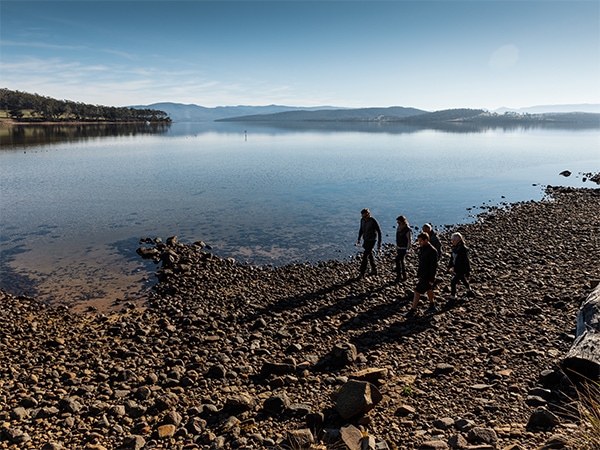
Discover the best of Bruny Island over a long weekend. (Credit Tasmanian Walking Holidays)
A road trip to Australia’s southernmost pub is really just an excuse to explore Tasmania’s beautiful Deep South: a journey that will first see you driving out of Hobart and into the apple-abundant food bowl that is the Huon Valley. Stop for an organic cider tasting or slice of apple pie at Willie Smith’s Apple Shed, just outside Huonville, then take the meandering Huon Highway further south still.
Visit Frank’s Ciderhouse & Cafe for a cheese platter in the riverside town of Franklin or continue on to Geeveston for what’s known as some of the best sushi in Australia at Masaaki’s Sushi.
From Geeveston, head west for 30 minutes towards the Hartz Mountains National Park to get high among the treetops. The spectacular Tahune AirWalk, an elevated walkway 30 metres above the forest floor, will have you walking above the forest canopy with heart-pounding views. Tahune Forest Adventures also offers walks around the area: stroll gently through Huon pines or brave the swinging bridges over the rivers; and, for the adrenalin junkies, there’s also a hang-gliding operation in the works.
Just 20 minutes from Geeveston, Dover is a small fishing village and a hub for apple orchards and fishing for salmon, abalone and crayfish. Beyond seafood, you’ll find the creators of the world’s first sassafras spirit, Bakehouse Distillery, here as well. Relaxed and quaint, Dover serves as a good base for your explorations further south (and provides ample unwinding, kayaking and beachwalking opportunities itself).
Driftwood Cottages’ collection of well-appointed self-contained waterfront studios or ocean-view cottages will do nicely. Nearby Southport will have you well placed for exploring the area, too, and you can’t go past a timeless and stylish B&B like The Jetty House.
It’s in this sleepy coastal town, Australia’s southernmost, that you’ll have reached Australia’s southernmost pub, the Southport Hotel. Stop here for a warm welcome, a cold schooner and some good country pub grub. Just 15 minutes from town, the Hastings Caves and Thermal Springs also provides ample reward for your troubles: investigate the richly decorated dolerite chambers of Newdegate Cave and soak in the warm waters of the site’s thermal springfed pool, surrounded by lush forest.
A further 40 minutes from Southport, Cockle Creek is the furthest point south you can reach in Tasmania by road. Sitting pretty on the beautiful Recherche Bay at the edge of the Tasmanian Wilderness World Heritage Area, with forest rolling down to meet a thin strip of golden sand and deep turquoise water, Cockle Creek is also the beginning of the challenging 84-kilometre South Coast Track. If you’re ready to start your next adventure.
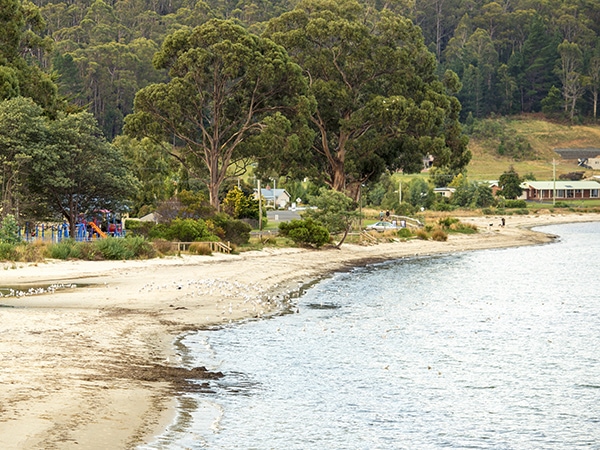
A walk on the beach in Dover in Tasmania. (Credit Tourism Tasmania & Rob Burnett)
LEAVE YOUR COMMENT